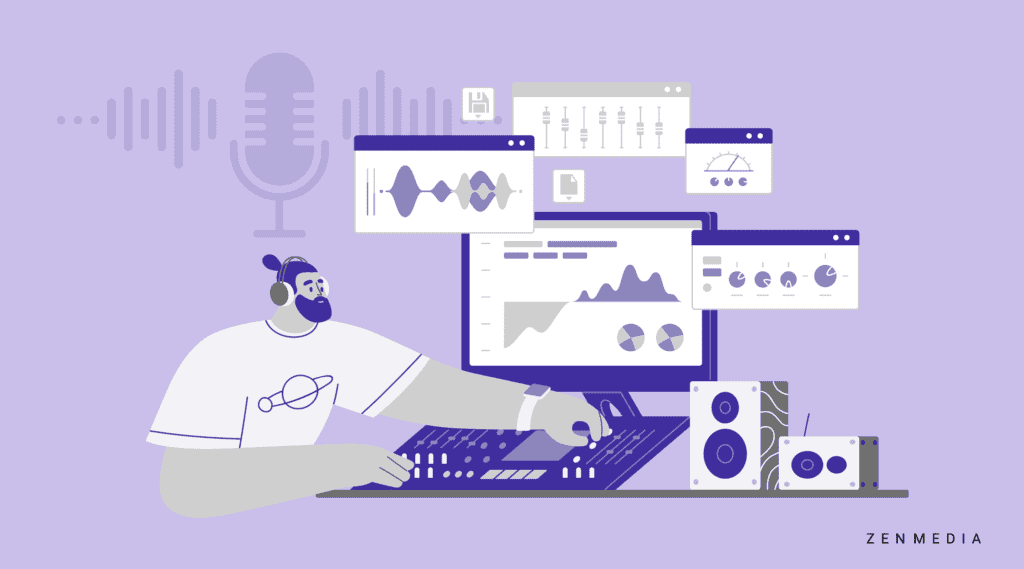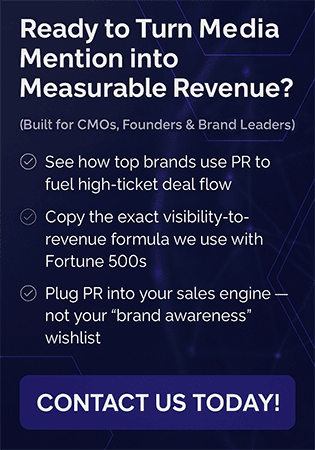The numbers speak volumes: with over 4 million active podcasts globally and nearly 500 listeners, podcasting has firmly established itself as a cornerstone of modern content strategy.
For B2B companies especially, podcasting offers a unique opportunity to demonstrate and establish thought leadership, build meaningful connections with audiences, and expand brand reach in ways traditional content simply cannot match.
Launching a podcast might seem intimidating at first, but with the right approach, any business leader or marketing team can create compelling audio content that resonates with their target audience. In this comprehensive guide, we’ll walk you through everything you need to know to launch, grow, and monetize a successful podcast.
Finding Your B2B Podcast’s Purpose and Voice
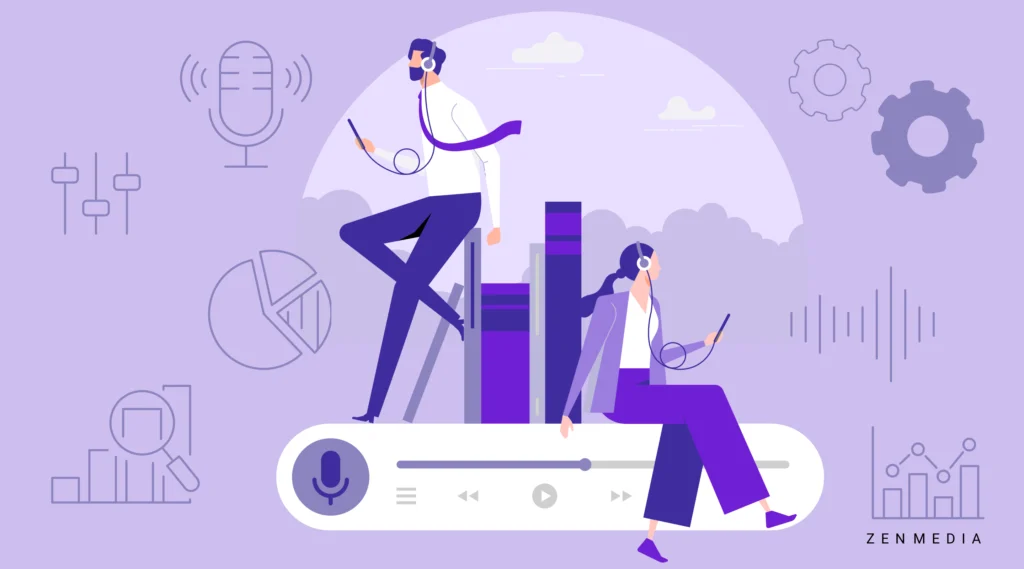
Before purchasing any podcasting equipment or booking guests, you need to establish a clear purpose for your podcast. This foundation will guide every decision moving forward.
Start by identifying specific goals for your corporate podcasting strategy. Are you aiming to:
- Generate leads?
- Build community within your industry?
- Educate prospects about complex solutions?
- Position executives as industry experts and thought leaders?
The most successful B2B thought leadership podcasts have concrete objectives that align with broader business goals. Keep this in mind before you start to create content.
Next, define your target audience with precision. Which decision-makers are you trying to reach? What problems keep them up at night? What information would they find valuable enough to dedicate 30-45 minutes of their time? Creating detailed listener personas helps ensure your content resonates with the right people.
Your podcast’s format should align with both your goals and audience. Interview-style shows work well for networking and showcasing diverse perspectives, while solo episodes allow for deeper dives into your company’s specific expertise. Panel discussions bring dynamic energy but require more coordination. Narrative-style podcasts demand higher production values but can create immersive experiences. All are good options, but you need to find the right style to deliver valuable content, build a loyal audience, and boost listener engagement.
Finally, choose a name that balances creativity with searchability. Your podcast title should clearly communicate the value listeners will receive while incorporating relevant keywords for discoverability. For CEO podcast production and executive podcast setup, maintaining brand alignment in your title is particularly important.
Planning Your Content Strategy
A sustainable B2B podcast content strategy starts with thorough planning.
Create a content calendar mapping out topics and each episode’s structure at least 8-12 weeks in advance. This provides a clear guide while allowing flexibility to address timely topics.
When developing episode topics, think beyond product features. The most engaging B2B podcasts address industry trends, explore common challenges, deliver valuable insights, and provide actionable solutions. Consider what unique perspectives your organization can offer that listeners can’t get elsewhere.
It’s also important to understand consistency builds audience trust and expectations, so establish a realistic publishing schedule. For 76% of listeners, regularity is valued over frequency, so it’s better to release quality episodes biweekly than rush weekly content that doesn’t meet your standards.
For each episode, develop a structured outline rather than a rigid script. This allows for natural conversation while ensuring you cover key points. Research thoroughly before recording, especially for interview episodes. Prepare thoughtful questions that go beyond what guests have discussed in previous appearances, and compile relevant data points to enrich the conversation.
Essential Podcast Equipment and Technical Setup

Professional podcast hosting requires appropriate equipment, but you don’t need to break the bank initially. For business podcast equipment, consider starting with these essentials:
Budget-friendly starter setup:
- A quality USB mic ($60-150)
- Headphones for monitoring sound quality ($50-100)
- Pop filter ($20-40)
- Optional: basic acoustic treatment for echo reduction in your recording environment ($100-500)
As your podcast grows, you might invest in:
- Dynamic XLR microphones ($150-400 each)
- Audio interface ($150-600)
- Boom arms and shock mounts ($50-250 per setup)
- Professional acoustical treatment ($500+)

For corporate environments, creating a dedicated recording space minimizes distractions and ensures consistent audio quality. Many companies are establishing professional studio setups and digital audio workstations as part of their office infrastructure. If space is limited, even a small conference room with proper acoustic treatment can work effectively. If you have plenty of room to spare, consider investing in a podcast studio that allows you to record high-quality audio and visual content for podcast videos that can be uploaded and shared across your channels.
For CEOs and executives with demanding schedules, remote recording devices are key. Invest in portable equipment for flexibility. Modern podcast recording software options range from beginner-friendly (Audacity, GarageBand) to professional (Adobe Audition, Logic Pro). For remote interviews, platforms like Riverside, SquadCast, and Zencastr record separate audio tracks for each participant, ensuring high-quality audio regardless of location.
Editing Software and Production Fundamentals
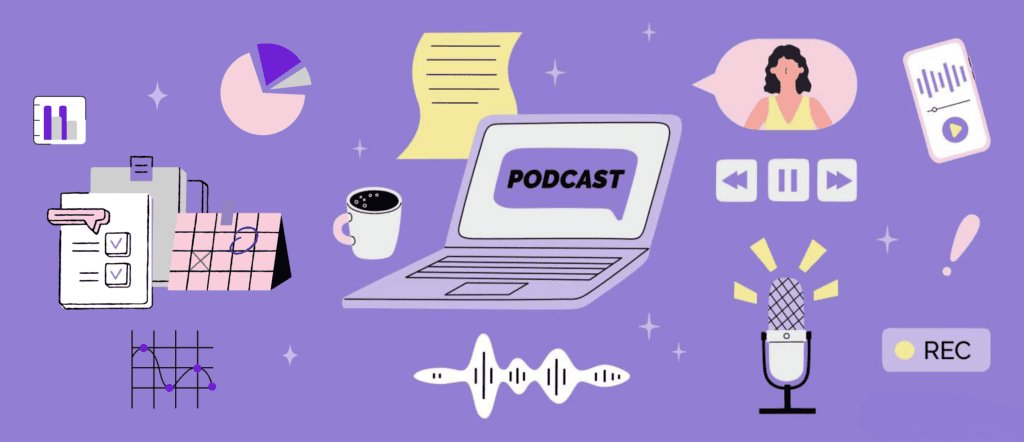
Your podcast’s recording quality forms the foundation of professional-sounding episodes.
Position podcast microphones about 4-6 inches from your mouth, slightly off-axis, to reduce plosives. Record in a quiet environment during off-hours when possible, and always do a short recording test to check levels before beginning.
For editing, start by focusing on content quality rather than perfect sound. Remove major mistakes, long pauses, and unnecessary tangents. Don’t over-edit natural conversation flow, as this can make dialogue sound unnatural. Background noise reduction and compression tools can significantly improve audio quality, but apply them judiciously.
Adding intro and outro music creates a consistent brand experience, but ensure you have proper licensing for any music used. Custom music composed specifically for your podcast represents a worthwhile investment for B2B brands serious about their corporate podcasting strategy.
Show notes and transcripts are also key components to consider. They improve accessibility, boost SEO, provide reference material for listeners, and create repurposing opportunities. You can also take valuable content from each episode and repurpose it across your website, social media platforms, and other marketing materials. Transcripts can be generated automatically then edited for accuracy, saving valuable production time.
Related reading: 30 Common Questions About Social Media Marketing Answered
Hosting and Distribution
Selecting the right podcast hosting platform forms a crucial part of your executive podcast setup. Popular options include Libsyn, Buzzsprout, and Podbean each offer different pricing structures and features. Key factors to consider include storage limits, bandwidth allowances, analytics depth, monetization tools, and website integration options.
Your hosting platform will generate an RSS feed—essentially the distribution channel connecting your podcast to various listening platforms. Once your RSS feed is configured, submit it to major podcast directories including Apple Podcasts, Spotify, and YouTube Podcasts. Each platform has specific submission requirements, so follow their guidelines carefully.
Understanding podcast analytics helps refine your strategy over time. Most hosting platforms provide basic metrics like downloads, listener geography, and platform preferences. However, these standard analytics have limitations—they typically can’t track individual listener behavior through an entire episode. Look for platforms offering enhanced analytics that reveal listener retention patterns, helping identify exactly when audience engagement peaks or drops.
Developing Your Podcast Brand

Your podcast’s visual and audio branding should align seamlessly with your company’s broader brand identity while standing strong on its own.
Invest in professional cover art that looks compelling even at small thumbnail sizes. This visual will often be potential listeners’ first impression of your podcast.
Episode descriptions deserve strategic attention—they’re not merely summaries but powerful marketing tools. Craft compelling descriptions incorporating relevant keywords while clearly communicating episode value. Include timestamps for major discussion points and links to resources mentioned.
For serious B2B podcast marketing efforts, consider creating a dedicated podcast website or landing page. This digital home base allows you to showcase episodes, provide additional resources, collect email subscribers, and capture leads directly. It also gives you complete control over presentation and user experience.
Growing Your Audience

Building an audience requires strategic promotion across multiple channels.
Start by leveraging existing marketing assets—company newsletters, blog posts, social channels, and customer communications. Create audiograms (short audio clips with visual elements) that highlight compelling moments to share across platforms.
Remember, social media is a powerful way to amplify podcast content. Spotify even said 42% of their listeners discovered new podcasts from social media in 2024. When building your promotion strategy, it’s important to understand that different platforms require tailored approaches to reach new audiences online. For example, LinkedIn works well for industry insights from thought leaders, while Instagram and TikTok favor personality-driven, concise content.
Email marketing remains highly effective for podcast promotion. Consider creating a newsletter specifically for podcast subscribers, offering exclusive content, early access to episodes, or bonus resources. This direct connection with listeners builds community while creating valuable first-party data.
Cross-promotion with complementary podcasts can rapidly expand your audience. Identify non-competing shows targeting similar audiences and propose mutually beneficial arrangements—guest appearances, promotional swaps, or co-hosted special episodes.
Related reading: Podcast Trends – 2025: Everything You Need to Know
Monetization Strategies

While building thought leadership often serves as the primary goal for corporate podcasts, monetization strategies can help offset production costs and demonstrate ROI. Sponsorships represent the most visible monetization path, with rates typically calculated on a cost-per-thousand-downloads (CPM) basis. Industry-specific B2B podcasts often command premium sponsorship rates due to their highly targeted audiences.
Premium content models offer another approach, where basic episodes remain free while in-depth content requires a subscription. This works particularly well for educational or specialized industry content where listeners derive clear professional value.
For B2B companies, lead generation often proves the most valuable podcast outcome. Strategic calls-to-action directing listeners to gated content, free consultations, or demo requests can convert engaged listeners into qualified prospects. Measuring this conversion path provides concrete data for corporate podcast ROI measurement.
Measuring Success and Iterating
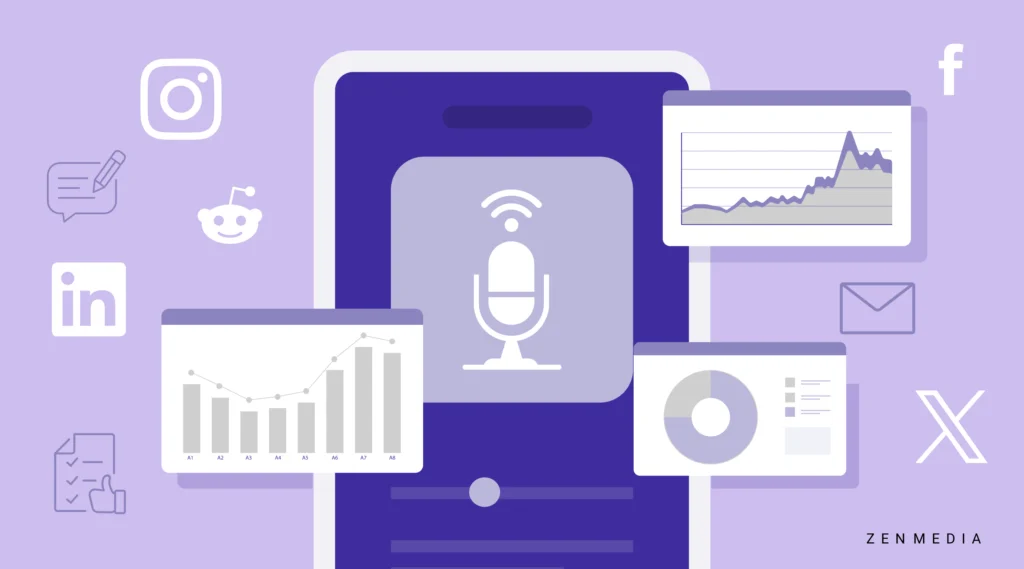
Effective measurement goes beyond download numbers. Establish key performance indicators aligned with your specific goals—whether that’s thought leadership positioning, lead generation, or customer education.
For audience growth, track download trends, subscription rates, and social sharing. For engagement, monitor completion rates, website traffic from podcast links, and listener interaction. For business impact, measure lead attribution, sales influenced by podcast touchpoints, and client/prospect feedback mentioning your podcast.
Regularly solicit listener feedback through surveys, social media, or dedicated email requests. This qualitative input often reveals insights that metrics alone can’t capture. Use this feedback alongside quantitative data to continuously refine your approach.
The most successful B2B podcasts evolve over time. Review analytics quarterly to identify what’s working and what isn’t. Which episodes perform best? What topics generate the most engagement? Which guests resonate with your audience? Let this data guide your content planning and production process.
Sustaining Long-Term Success
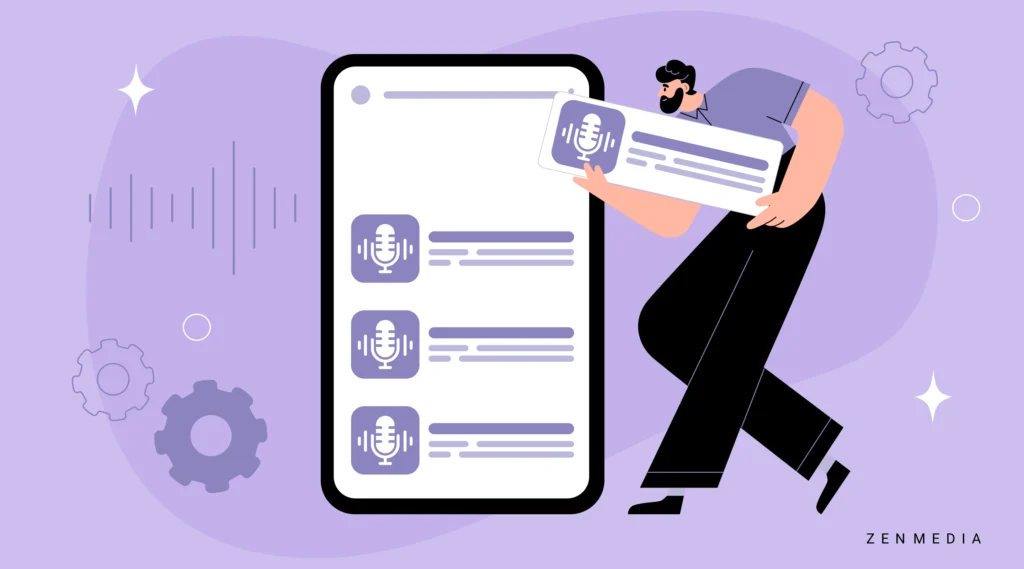
Building a successful B2B thought leadership podcast requires commitment beyond the initial launch excitement. Create systems that ensure consistency even when key team members are unavailable. Consider batch recording episodes when schedules allow, building a content buffer for busy periods.
Refresh your approach periodically to prevent content stagnation. This might involve introducing new segments, experimenting with formats, or addressing breaking news and emerging industry trends. Keep the core value proposition consistent while allowing your podcast to evolve with your audience’s needs.
As your audience grows, look for opportunities to extend your podcast beyond audio. Live events, video components, companion resources, and community building initiatives can transform a simple podcast into a comprehensive content ecosystem that delivers value across multiple touchpoints.
Making the Most of You Podcast Content
Launching a podcast represents a significant commitment, but the potential rewards for B2B companies make it well worth the investment. Beyond the immediate benefits of content creation and audience engagement, podcasting builds valuable skills within your organization—from communication and storytelling to technical production and promotion.
The intimate nature of audio creates connections with listeners that few other mediums can match. When executives share authentic insights and experiences through a well-produced podcast, it humanizes your brand while establishing credibility that transcends traditional marketing.
Whether you’re just beginning to explore podcasting or looking to elevate an existing show, approaching the medium with strategic intention and a commitment to quality will set you up for success. By focusing on delivering genuine value to your audience rather than simply promoting your offerings, you’ll create a podcast that serves as both a powerful marketing asset and a valuable industry resource.
Ready to launch or optimize your B2B podcast? Our team of content strategists and promotion specialists can help you develop and execute a podcasting strategy aligned with your business goals. From concept development to audience growth, we provide the expertise and support needed to make your podcast a cornerstone of your content marketing strategy.
Contact us today to discuss how we can help amplify your brand’s voice through the power of podcasting.


